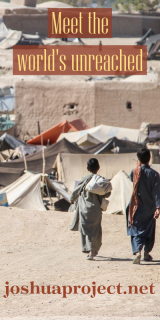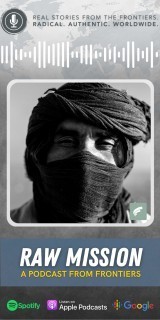Develop and Implement a Contextual Prayer Strategy
24:14 Goal—Movement engagements in every unreached people and place by 2025 (32 months)

Why develop a prayer strategy?
While my family served in Asia, my husband and I visited a team on an island a short flight away. They had experienced many setbacks to sharing Jesus with those around them. Their children often had nightmares, as did those who slept in the guest room of their house. The team leader's wife struggled with depression and suicidal thoughts, which she had never experienced before moving to that location. Kingdom work and the team limped along. A prayer calendar had been developed by the team, but it encountered multiple setbacks and delays before it was finally printed. When the team investigated the spiritual history of that area, they discovered (among other things) that human sacrifice had been practiced there until the early 1900s.
When the prayer calendar was finally printed, that area was featured in the Global Prayer Digest also, which mobilized even more prayer. Prayer always precedes breakthrough. And, initial breakthroughs came, and the work continues to this day. So also do the challenges and the need for more focused prayer.
As Walter Wink wrote:
Intercessory prayer is spiritual defiance of what is in the name of what God has promised. Intercession visualizes an alternative future to the one apparently fated by the momentum of current forces. Prayer infuses the air of a time yet to be into the suffocating atmosphere of the present. ... History belongs to the intercessors who believe the future into being. ... Even a small number of people, firmly committed to the new inevitability on which they have fixed their imaginations, can decisively affect the shape the future takes.1
Scripture teaches much about the importance of prayer. It highlights praying effectively and fervently, in holiness: The prayer of a righteous person has great power as it is working. (James 5:16b). It teaches us to pray together in agreement with others: Again I say to you, that if two of you agree on earth about anything that they may ask, it shall be done for them by My Father in heaven (Matt. 18:19). And it encourages us to pray always with rejoicing and thanksgiving: Rejoice always, pray without ceasing, give thanks in all circumstances; for this is the will of God in Christ Jesus for you (1 Thess. 5:16-18). Much more could be said about Scripture's teaching on prayer.
How can we pray more effectively?
Our God invites us into deep relationship with himself and prayer is a very important part of that relationship. It involves asking, listening, resting, abiding, seeking, and more. It's not meant to be part of a checklist. Praying is about communicating with the Heavenly Father. Praying more effectively is about growing in connection with our Lord, aligning with His heart and purposes, seeking Him above all, and living in holiness. As we spend time with our King, we grow in faith and joy, and in recognizing that He is good and delights in hearing our prayers and answering them.
One way to grow in praying more effectively is to learn from prayer strategies in Scripture. To mention only a couple of many, in 2 Corinthians 10:3-5 we learn that we have been given divine power to tear down1 strongholds. John 14:12-14 teaches us to believe and ask in Jesus' name. Esther mobilized backup prayer and fasting before asking the king for help (Esther 4:12-17).
Looking at the following two passages gives insight into the prayer strategy of identifying strongholds, hindrances to the advance of God's kingdom in a location, situation, or group of people (2 Cor. 10:3-6), and kingdom opposites, what it might look like for God's kingdom to come and His will to be done in that place (Matt. 6:9-13).
Strongholds in a people or place can affect lost people, disciples, and gospel messengers. Negative effects can include nightmares, suicidal thoughts, division, intrusive thoughts, anger, infighting, fear, intimidation, sexual sin, unfaithfulness, miscommunication, sickness, and more. All too often these challenges debilitate God's people. Yet God's good plan is to give His people victory over the stronghold, then have them bring this victory to the lost, setting captives free. In this process, strongholds are demolished, God's kingdom expands, and He gets all the glory.
When we first moved to Asia, a huge stronghold in my life was fear. It was also a stronghold among the Unreached People Group we sought to serve. As God set me free from fear, He led me to deeper faith and hope. Then I was more able to pray this same victory for those around me. God gave me significant insights about that road, which I was able to pass along to others. One fruit of this was the birth of Wholeness Prayer (www. freemin.org), which God has since used to set many spiritual and emotional captives free, as He speaks to the roots of the issues involved.
Another place my husband and I lived in Asia suffered from a stronghold of division. A kingdom opposite to that is unity. A related key Scripture is John 17. Many of the churches in that city regularly join together to pray for unity. They also hold multi-denominational events and seek to speak well of one another.
Once strongholds are identified, they can be integrated into a broader prayer strategy. For example, if the strongholds are nightmares, intimidation, and intrusive thoughts, a prayer strategy might include putting on the armor of God, rejoicing in the power of God, and developing a month-long prayer campaign.
Develop an effective prayer strategy
A first step is to identify key strongholds hindering kingdom advance in a group or location. This can be done through prayerful observation, asking key questions to cultural insiders, researching the history of the location or group, and spending time in prayer (as a group and individually) asking God to reveal whatever we need to know about strongholds affecting that location or group.
Follow-up steps include prayerfully seeking to identify kingdom opposites for each of these strongholds, identifying key Scriptures that connect with these, then using those Scriptures as the basis for effective prayer. Once you've created and implemented your prayer strategy, you'll want to periodically evaluate it, then update it as needed.
Real Strongholds, Real Strategies
After moving to a new location in Asia, I noticed that I was more inclined to be irritated with my husband. I would hear a voice in my head saying, "Find something to get irritated at him about." Since that's not a common issue for us, I started asking other workers in that area if they were also experiencing this. They were! So, a group of us began to pray together about this stronghold we'd identified. Once this stronghold was brought into the light, its power decreased.
In that situation, one potential kingdom opposite we could have focused on is thankfulness. A related verse is 1 Thessalonians 5:18: Give thanks in all circumstances; for this is the will of God in Christ Jesus for you.
A prayer strategy we might have chosen would be for this group to pray weekly about this issue, and invite others to do the same, and ask God to birth thankfulness in His people and in that location. An additional step could be to see how we could practice and model thankfulness and hold each other accountable to do so.
Think about your context (or the one for which you are interceding). What strongholds are there? Then, consider:
- When do you plan to pray (rhythms of prayer)?
- What are you planning to pray (prayer strategy)?
- Who will you share your prayer initiative with?
- Who will you pray with?
- What are the next steps?
What does it mean to multiply prayer?
It's often helpful for many people to join together in agreement about a hindrance to kingdom advance. There is kingdom power when one person prays. And there is power where two or more are gathered in his name, agreeing together about what they are asking God to accomplish.
Key ways to multiply prayer include: (1) more and more people praying, (2) praying longer or more frequently, (3) praying more strategically (e.g., using strategies from Scripture), (4) praying more fervently or from a place of increased desperation, (5) praying from a place of deeper connection with God, and (6) praying from a place of greater purity or deeper surrender.
Extraordinary prayer has preceded every Church Planting Movement we know of. It goes beyond the ordinary in commitment, desperation, frequency, and/or quality, with the goal of engaging with God at a deeper level. The following are extraordinary prayer strategies organized by the acronym PRAY2:
Prepare the way for the coming of His kingdom: prayer as strategy; listening prayer; prayer mobilization, training and team building and prayer shield teams and prayer research-which is Spirit- guided research into the supernatural underpinnings of reality to help produce more informed, effective intercession and outreach.
Restore God's rightful rule: prayer worship warfare, i.e. raising the waterline of God's manifest presence through worship, engaging with God, proclaiming His will, and exercising His delegated authority through supplication and obedience; prayer as member health; prayer as representational repentance and reconciliation; prayer and crisis response; and prayer and suffering.
Advance of His kingdom for His glory: prayer walking-when we carry His presence as we move prayer out of the church building or home and into the community; prayer power evangelism; prayer as spiritual warfare, i.e. taking authority over spiritual powers and strongholds hindering the advance of God's kingdom; prayer and fasting for breakthroughs; and prayer presence.
Yearn for the now-but-not-yet kingdom to come: prayer yearning for maturity; prayer yearning for the full harvest-pressing forward with urgency to reap the white harvest that the Lamb who was slain receive His full reward; prayer yearning for kingdom transformation; and prayer yearning for our Bridegroom.
Consider which of these extraordinary prayer strategies you might want to include in your personal prayer strategy.
Length of prayer strategies
Prayer strategies may span short, medium, or long-term timelines. They may involve just a few people or even millions, praying individually and together. One shorter prayer initiative I pursued was fervent prayer for one of our sons while he was hospitalized with dengue fever. In God's graciousness, He granted complete healing in a relatively short period of time.
In "Gaining Church Planting Momentum During COVID-19," Aila Tasse described their responses to numerous challenges COVID-19 brought to their ministry in 2020:
Our first response was prayer. In mid-March we called for prayer among all our team members: our core team and our country leaders, representing all the countries where we work. We all started praying at the same time, using WhatsApp to distribute the prayers. We prayed that God would sustain the movement, because we realized that leaders and families were suddenly losing all their sources of income. Prayer was very key for us to keep the momentum. We all started praying, especially on Tuesdays and Thursdays. We called for fasting on Wednesdays. It was a whole day of fasting every week, which still continues today.3
He later described God's provision in response to their prayers:
I looked at what has happened in the last 15 years of our movement in East Africa, and 2020 was the peak. We saw 1,300 churches planted in just that one year. This was amazing because earlier in the year, we had scaled down our goals by 30%; we said we'll trust God for 600 to 800 new churches. But God took us way beyond that, as only He can do. I could hardly believe it, as all the teams presented their data for the year. I had to see the graphs and look for myself at people group by people group.4
A lifelong prayer that I, and many others, are committed to pursue is for John 17 unity and shalom wholeness in the global Church. Whatever the length of the prayer strategy, and however you update it over time, keep praying and persevering in faith. As my brother, JFK Mensah, so aptly described,
We must believe in the weapons of our warfare. Over time there is no curse that can't be broken. To believe otherwise is to believe a lie. Have courage! You are seated with Christ in heavenly places. You are tiny, but the weapons are mighty.5
Whatever God calls you to pray for, don't stop. Align with His vision and promises and pray them into being. His victory is certain. He is bigger and more powerful than any problem, and all problems combined. Rejoice in Him, worship with joy, and give thanks in all circumstances. As He answers your prayers, give appropriate testimony (consistent with confidentiality). And give Him all the praise and glory.
Steps to develop a prayer strategy
Here are some steps for developing and implementing a prayer strategy in response to an ongoing situation.
- Develop the prayer strategy (as a group).
- What strongholds/hindrances are factors in this situation?
- How are they affecting the lost, the church, individuals, families, groups, and/or field workers?
- What are the historical roots of these strongholds or hindrances?
- What kingdom opposites do you sense God wants to bring in their place?
- What verses connect with each of these kingdom opposites?
- What initial prayer strategy will you pursue? i.e., Who, when, how, where, and resources, rhythms, or other activities.
- What prayer materials will you create?
- What rhythms of prayer will you pursue?
- How will this multiply prayer?
- Implement the prayer strategy.
- Periodically evaluate and update the prayer strategy.
- What progress has been made?
- In what ways is the situation unchanged?
- How have the challenges and opportunities changed?
- Based on the above, how will you update your prayer strategy?
- Repeat as new situations arise.








comments